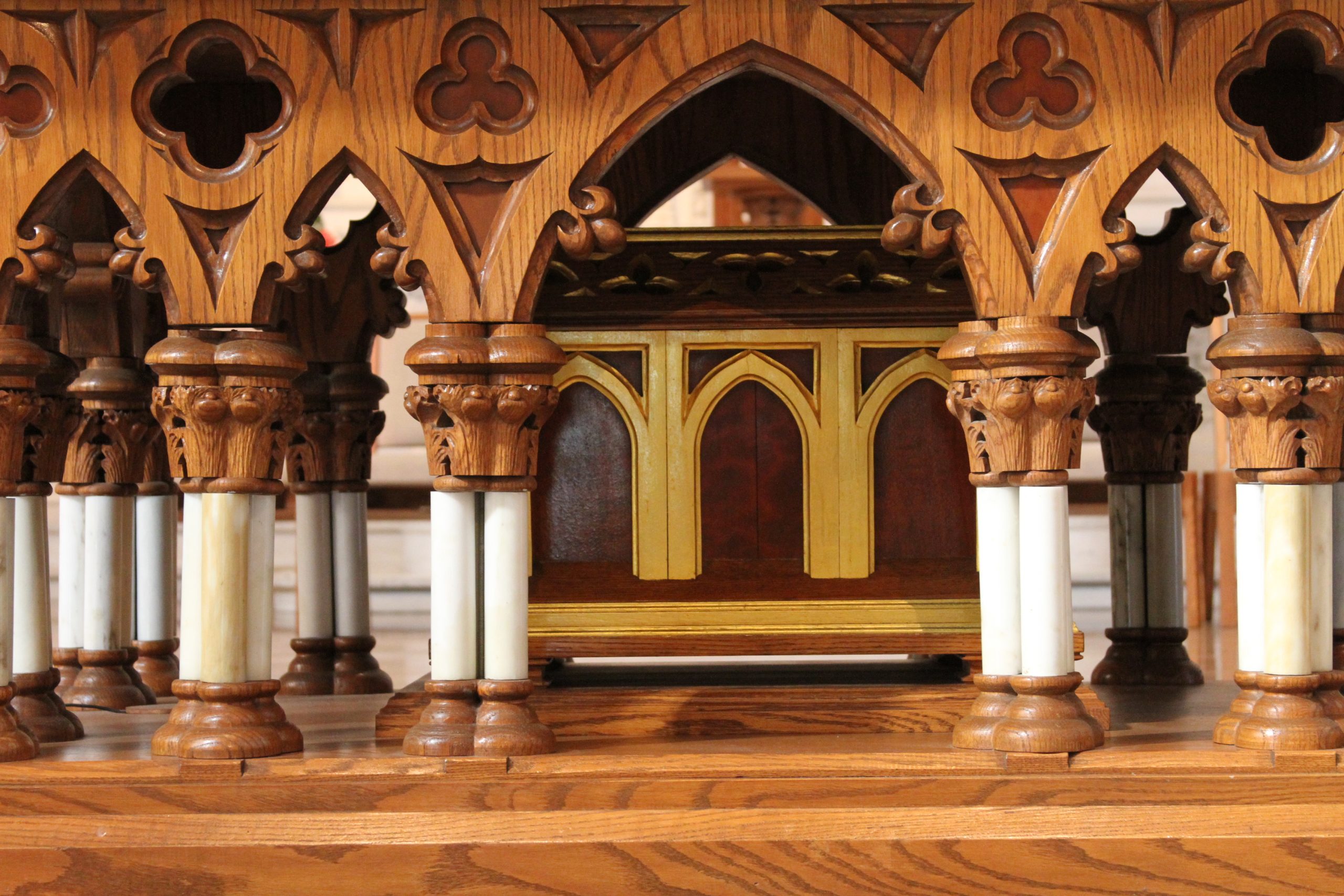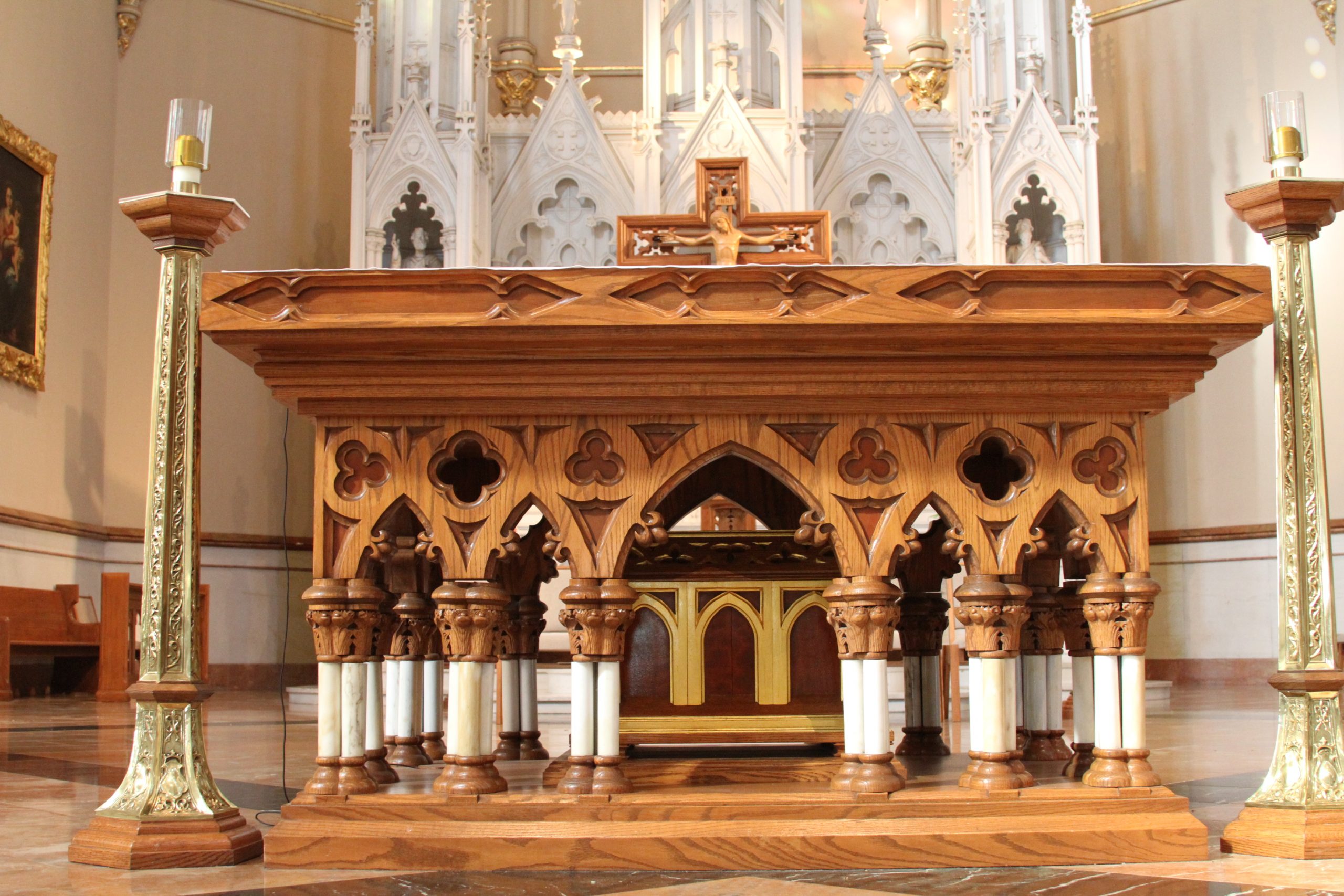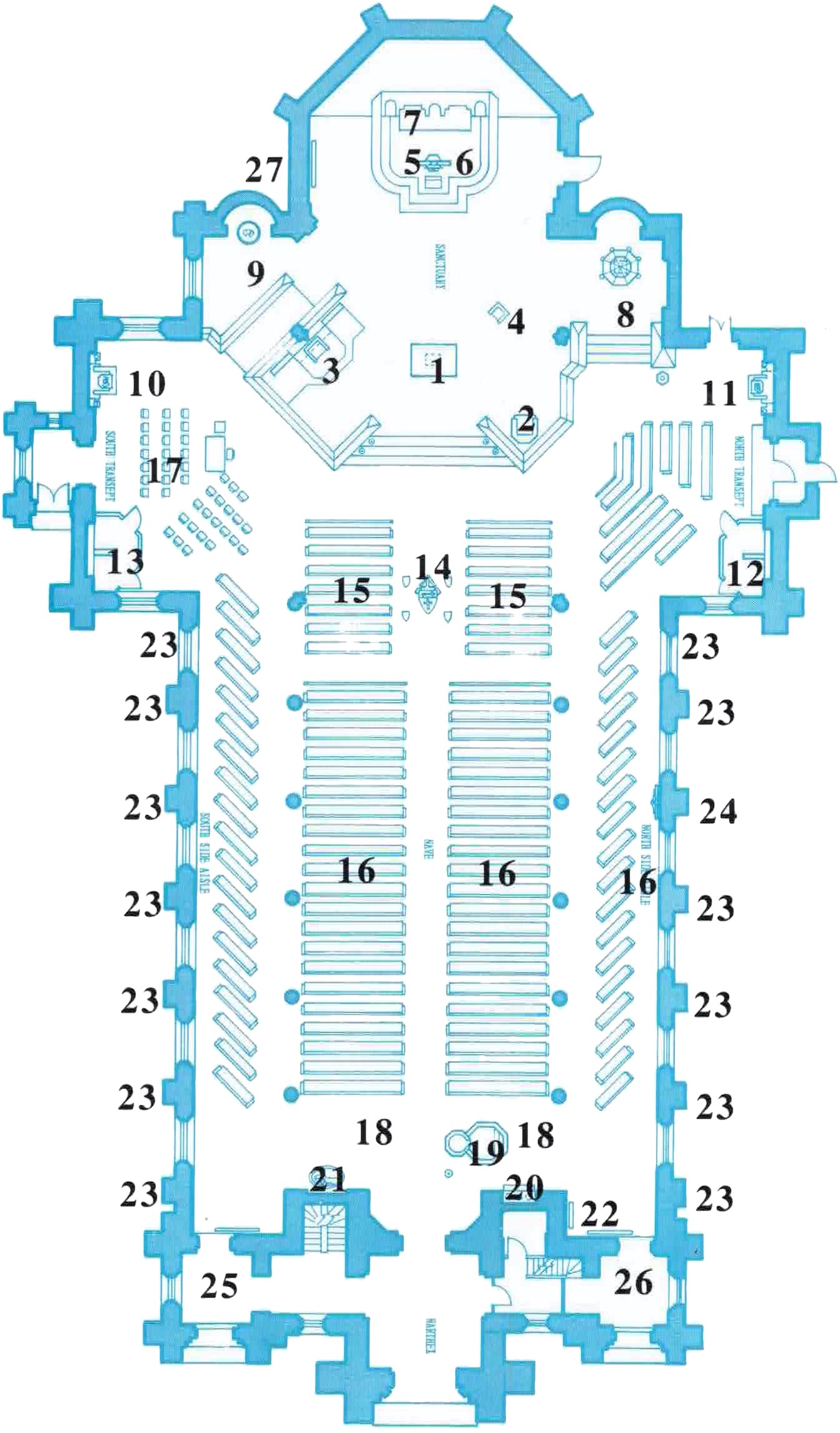St. Peter Cathedral Art & Architecture
The top of the altar or mensa is made of oak and cherry inlays forming a Jerusalem cross. Fifty-two white marble columns support the mensa, each four- and three-column pillar hold a hand-carved capitol which vaults to the next group of columns.
Beneath the altar table is a carved oak and cherry reliquary containing 84 true and verified relics of the saints and martyrs, holy men and women, including Saint Patrick, patron saint of the diocese. So we may truly say that it is on the faith, the blood and the love of those who lived and died for Christ that we celebrate.
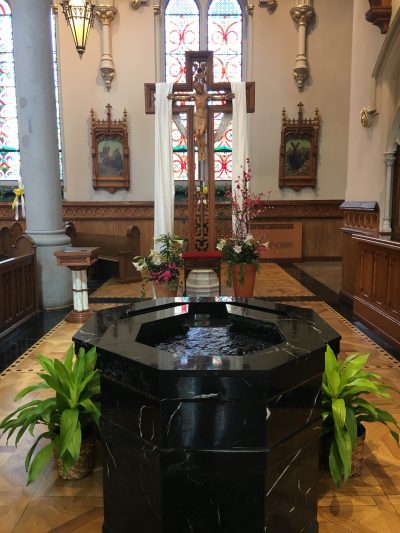 The Cathedral’s baptistry is located close to the front doors of the Cathedral to recall that through the Sacrament of Baptism we enter the Church of Jesus Christ.
The Cathedral’s baptistry is located close to the front doors of the Cathedral to recall that through the Sacrament of Baptism we enter the Church of Jesus Christ.
The font has upper and lower wells to allow baptisms by pouring or immersion. Warm, clear water springs from the upper and cascades down to the lower well. The font features a blue pearl granite interior with inlaid gold mosaics of the morning sun to symbolize our awakening to Christ and everlasting life. The exterior is dark green marble which is used throughout the Cathedral to trim the gathering space, center aisle and sanctuary.
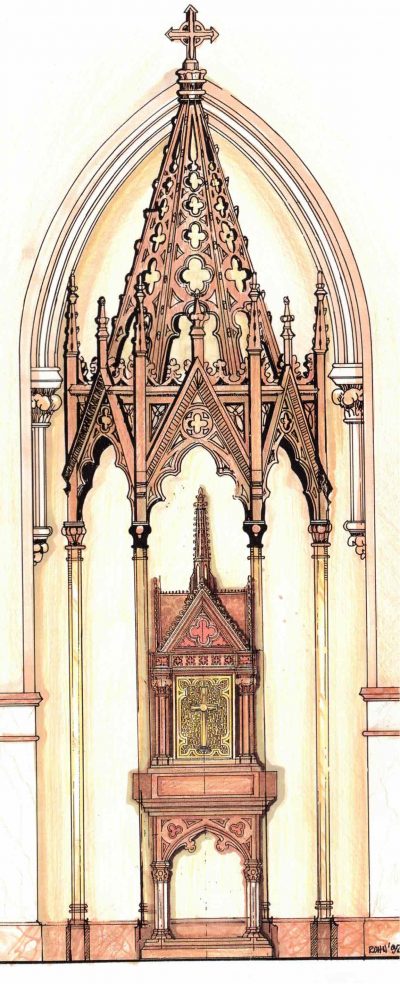 As Moses housed the Ark of the Covenant in a tent in the desert, we today, as Catholic Christians, carry forward this tradition and set the Most Blessed Sacrament under a baldachin or canopy to signify the presence of God.
As Moses housed the Ark of the Covenant in a tent in the desert, we today, as Catholic Christians, carry forward this tradition and set the Most Blessed Sacrament under a baldachin or canopy to signify the presence of God.
The baldachin, formerly located above the original Cathedra, was redesigned during the Cathedral renovations in 1992 to encase the tabernacle. Its natural oak finish was completely restored. Brass legs, trimmed in oak, were added on four sides to frame the tabernacle. The front section remains open and visible to the community.
In keeping with the other liturgical furnishings found in the Cathedral, the chair of the bishop is made of oak and cherry woods. The seat is large enough for the bishop to sit in full liturgical vestments.
The backdrop of the cathedra is fabricated from Spanish rosa duquesa marble and trimmed in red oak and cherry. The marble columns are made from Italian Calcutta marble. In the center of the field, the arms of the current Bishop of Erie is mounted.
 The cross is the symbol of our salvation. The Cathedral’s oak and cherry gothic cross located near the baptistry is 18 feet tall and clearly visible to all. The large cross holds the processional cross, behind which the faithful gather in procession and celebration of the mystery of the Lord’s life, death and resurrection. The linden wood corpus on the processional cross is four feet tall and, at rest, gives the appearance that Christ’s arms are embracing the sanctuary.
The cross is the symbol of our salvation. The Cathedral’s oak and cherry gothic cross located near the baptistry is 18 feet tall and clearly visible to all. The large cross holds the processional cross, behind which the faithful gather in procession and celebration of the mystery of the Lord’s life, death and resurrection. The linden wood corpus on the processional cross is four feet tall and, at rest, gives the appearance that Christ’s arms are embracing the sanctuary.
The oak and cherry woods forming the Cathedral furnishings are native to the Diocese of Erie. Each piece is made of solid stock. The pieces were kiln-dried, planed, laminated and carved.
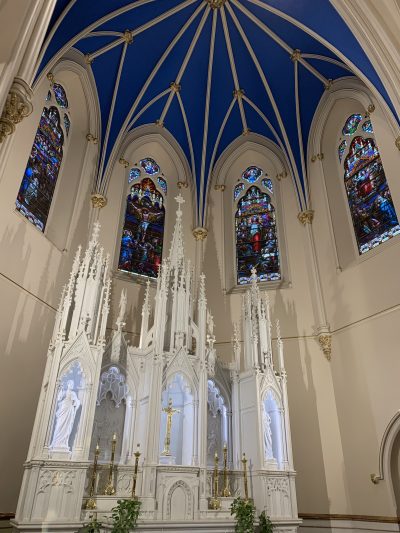 Prior to the liturgical changes of the Second Vatican Council, the Reredos contained the Altar of Sacrifice where priests and the Bishops of Erie would celebrate Holy Mass. During the Cathedral renovations, the Reredos, which is made of white carrara marble, was cleaned and restored and remains the primary backdrop in the Sanctuary. The Reredos features statues of Saint Peter and Saint Paul, and bas-reliefs depicting the sacrifices of Isaac and Melchisedec. Beneath the old High Altar is a splendid sculpture of the burial of Christ (the New Testament sacrifice). More recently, the reredos was illuminated with LED lights to further accentuate the many details carved into this priceless Cathedral treasure.
Prior to the liturgical changes of the Second Vatican Council, the Reredos contained the Altar of Sacrifice where priests and the Bishops of Erie would celebrate Holy Mass. During the Cathedral renovations, the Reredos, which is made of white carrara marble, was cleaned and restored and remains the primary backdrop in the Sanctuary. The Reredos features statues of Saint Peter and Saint Paul, and bas-reliefs depicting the sacrifices of Isaac and Melchisedec. Beneath the old High Altar is a splendid sculpture of the burial of Christ (the New Testament sacrifice). More recently, the reredos was illuminated with LED lights to further accentuate the many details carved into this priceless Cathedral treasure.
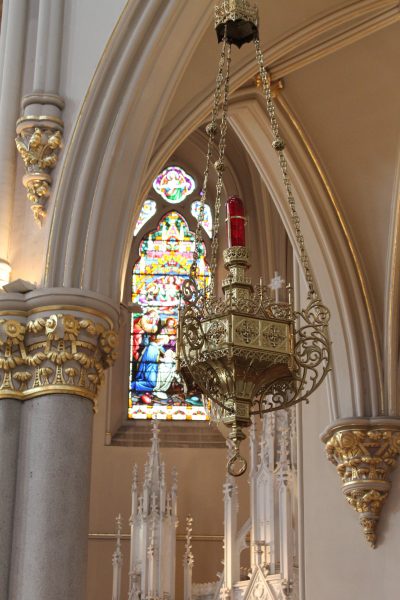 The flame within the Sanctuary Lamp shined continually, except Holy Thursday to Easter Sunday, as a symbol of the Light of Christ and the True Presence of Christ in the Eucharist reserved in the Tabernacle. At Saint Peter’s Cathedral, the highly polished, ornate Lamp holds a hand-blown glass globe in which the candle burns. The lamp was completely restored in the 1992 renovation.
The flame within the Sanctuary Lamp shined continually, except Holy Thursday to Easter Sunday, as a symbol of the Light of Christ and the True Presence of Christ in the Eucharist reserved in the Tabernacle. At Saint Peter’s Cathedral, the highly polished, ornate Lamp holds a hand-blown glass globe in which the candle burns. The lamp was completely restored in the 1992 renovation.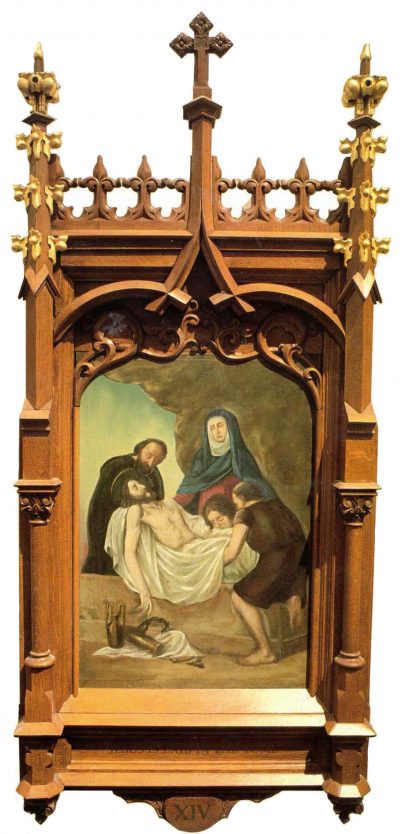 The Stations of the Cross trace the last journey of Jesus from accusation and condemnation through his final steps up Calvary, to his death and burial. The stations of the cross in the Cathedral are paintings with gold-leafed oak frames.
The Stations of the Cross trace the last journey of Jesus from accusation and condemnation through his final steps up Calvary, to his death and burial. The stations of the cross in the Cathedral are paintings with gold-leafed oak frames.
The twelfth station is unique, however, and is a brilliant bronze sculpture of Christ crucified. The crucifix was originally located in the north transept. Both the cross and corpus have been ebonized. Upon seeing it restored during the 1992 restoration, Bishop Trautman suggested making this work of art the twelfth station, “Christ Crucified.”
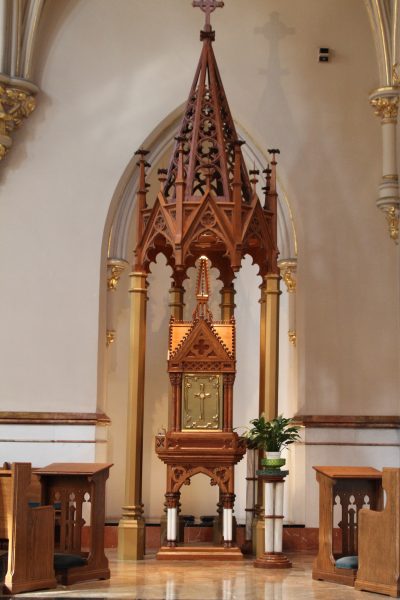 Designed in a cruciform shape from polished bronze and carved oak, the tabernacle holds the reserved Blessed Sacrament. Its strong gothic character features a center spire accented with small carvings and inlaid cut crystal engraved with the symbols of Christ. Each side of the Tabernacle is adorned with an image of Christ, Christ crucified, Christ resurrected, Christ of the Word and Christ of the Eucharist.
Designed in a cruciform shape from polished bronze and carved oak, the tabernacle holds the reserved Blessed Sacrament. Its strong gothic character features a center spire accented with small carvings and inlaid cut crystal engraved with the symbols of Christ. Each side of the Tabernacle is adorned with an image of Christ, Christ crucified, Christ resurrected, Christ of the Word and Christ of the Eucharist.
The Tabernacle rests on an oak and cherry throne with a dark green marble top and is accented with marble columns.
Floor Plan of the Cathedral
- Altar of Sacrifice
- Ambo
- Cathedra
- Presider’s Chair
- Processional Cross
- Enthronement of the Gospels
- Reredos
- Tabernacle
- Marian Shrine
- Sacred Heart Shrine
- Saint Joseph Shrine
- Chapel of Reconciliation
- Chapel of Reconciliation
- Diocesan Seal and Coat of Arms
- Daily Seating for the Liturgies
- Extended Seating for the Liturgies
- Choir, Organ and Cantor Area
- Gathering Space
- Baptismal Font
- Ambry (Holy Oils)
- Pieta Statue
- Memorial Enthronement
- Stations of the Cross
- Station 12 — The Crucifixion
- Mural — Nativity
- Mural — Crucifixion
- Mural — Madonna and Child


